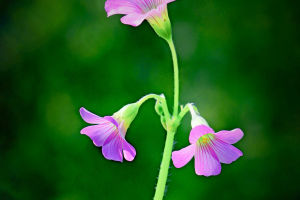Oxalis corymbosa, commonly known as the pink wood-sorrel or Mexican shamrock, is a plant species belonging to the Oxalidaceae family. Native to Mexico and Central America, this perennial plant is prized for its ornamental value and has gained popularity as a houseplant due to its attractive foliage and delicate flowers.
The plant is typically grown for its three-leafed shamrock-like leaves that come in a vibrant shade of green. Each leaf is composed of three heart-shaped leaflets with a distinctive clover-like appearance. The leaves are borne on long, slender stems that grow up to 12 inches in length. When the plant is exposed to bright light, the leaves may take on a slight reddish tint.
The flowers of Oxalis corymbosa are equally charming. They are small, measuring only about 1 inch in diameter, and are borne in clusters on delicate stalks. The flowers have five petals that are soft pink or white in color, with a yellow center. The blooms typically appear in late winter or early spring and last for several weeks.
Oxalis corymbosa is relatively easy to grow and care for, making it a popular choice for both novice and experienced gardeners. The plant prefers well-drained soil that is kept moist but not waterlogged. It thrives in bright, indirect light and prefers temperatures between 60 and 80 degrees Fahrenheit.
One of the key things to keep in mind when growing Oxalis corymbosa is that the plant goes dormant during the summer months. During this time, the leaves will yellow and wither away, leaving only the bulbs and roots. It is important not to water the plant during this period as it can cause the bulbs to rot.
To propagate Oxalis corymbosa, gardeners can simply divide the bulbs. The best time to do this is in the fall when the plant is beginning to emerge from its dormancy. The bulbs should be carefully dug up and divided into smaller sections, each with at least one leaf attached. These can then be replanted in fresh soil and watered regularly.
While Oxalis corymbosa is generally a low-maintenance plant, there are a few pests and diseases that can affect it. The most common pest is spider mites, which can be easily treated with a spray of water or insecticidal soap. The plant may also be susceptible to root rot if it is overwatered or grown in soil that is too wet.
In terms of its medicinal properties, Oxalis corymbosa has been traditionally used by indigenous cultures in Mexico and Central America to treat a variety of ailments. The plant contains oxalic acid, which is believed to have anti-inflammatory and analgesic properties. It has been used to treat stomach ulcers and headaches, and even as an antidote for snake bites.
However, it is important to note that the plant should not be consumed in large quantities as it can be toxic in high doses. The leaves and bulbs contain oxalic acid, which can cause stomach upset and even kidney damage if ingested in excessive amounts.
Oxalis corymbosa is a delightful plant with attractive foliage and charming flowers that make it a popular choice for indoor and outdoor gardens. While it is relatively easy to care for, it is important to keep in mind its dormancy period and avoid overwatering. With proper care, this plant can thrive and bring joy to its caretakers for many years to come.


